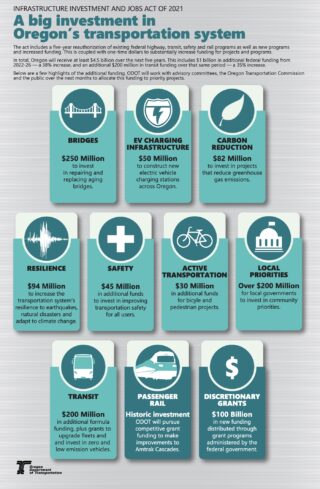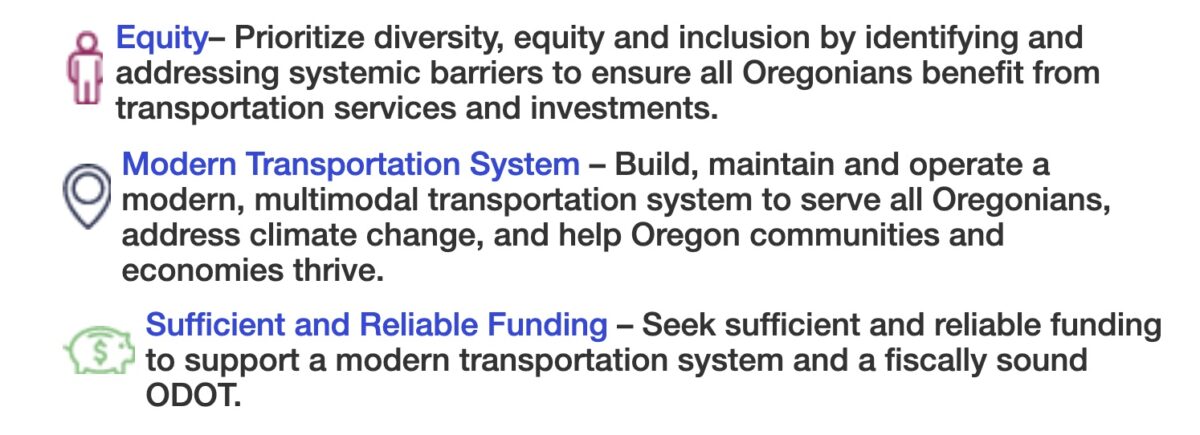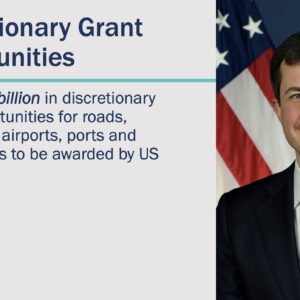
(Photo: Jonathan Maus/BikePortland)
Here we go.
This morning the Oregon Department of Transportation announced the first step in a process to decide how to spend the $1.2 billion federal largesse headed our way thanks to the Biden infrastructure package, or what is technically referred to as the Infrastructure Investment and Jobs Act (IIJA).
With Oregon’s transportation priorities and the institutional culture of ODOT the focus of more criticism and attention than ever due to their stubborn allegiance to projects that expand freeways and driving capacity, how the Oregon Transportation Commission (OTC) decides to spend this funding will be a key indicator of whether or not our state is ready to begin a new chapter. It’s clear the status quo isn’t an option. The questions that face us are: How far beyond it can we push? And how fast we can get there?
ODOT needs our help to answer these questions, and a webinar planned for December 7th will your first opportunity to influence them.
To refresh, there is a lot at stake here because 1) there’s a lot of money on the table and 2) the timeline to get it “out the door” is relatively very short.
Advertisement

Beyond the usual flexibility ODOT (and cities) will have in how they spend federal funds, the IIJA has a “huge amount” (ODOT’s own words) of discretionary grant programs. ODOT Finance Director Travis Brouwer has told us he expects Oregon to win an additional $200 million per year from a program that will be managed by US DOT Secretary Pete Buttigieg. That’s in addition to the 38% and 35% increases in “highway” and transit funding (respectively) already in the bill.
As for the timeframe, Brouwer said there’s about $150 million in funds that will have to be obligated within the next four months. That is lightning fast compared to the typical, multi-year process.
Speaking of process, you can expect to hear a lot from ODOT about the allocation of $2.2 billion for their Statewide Transportation Improvement Program (STIP) back in December 2020. ODOT staff have been touting that process a lot because they believe it shows their commitment to go beyond the car-centric investments of the past. The 2024-2027 STIP process was the first ever that scored the various funding proposals against climate and equity metrics. With that new lens, combined with a lot of public pressure, the OTC ended up funding the “non-highway” pot at $255 million, a 60% increase from the previous STIP, but still a small amount compared to the $865 million that went to traditional “highway” projects. (Keep in mind “highway” projects very often include bicycling, walking and transit elements.)
Note that in in their email this morning about the IIJA webinar, ODOT asked (emphasis mine), “Given the investments already made in the Statewide Transportation Improvement Program and the federal infrastructure bill, how should the OTC allocate flexible funding to best advance the OTC/ODOT Strategic Action Plan and the state’s transportation goals?”
There are many ways one could read that emphasis on the STIP in that sentence. Is ODOT trying to say, “We began a movement toward non-highway that we want to continue,” or are they saying, “We’ve already set aside a record amount of non-highway funding, so please be reasonable and let us use this money for more freeway expansions.”
Watch ODOT’s framing very carefully because they are masters at stacking the deck for their preferred outcome.
The other question ODOT wants you to answer is: “What are the specific priorities for investment of funds in public and active transportation?”

Another thing to keep in mind is that the OTC/ODOT Strategic Action Plan includes “equity” and “multimodal transportation system to serve all Oregonians,” as two of its three main priorities.
So it’s time to organize your friends and your arguments and give ODOT an earful of good ideas and quality feedback.
Here’s how to do it:
Webinar: 12/7 from 9:00 to 10:30 am – Zoom meeting link
Public comment at webinar: Email chloe.craft@odot.state.or.us to get your spot. Each person will get up to three minutes to speak.
Written comment: ODOT is also accepting written feedback to share with OTC members and ODOT senior staff. You can submit comments online here.






Thanks for reading.
BikePortland has served this community with independent community journalism since 2005. We rely on subscriptions from readers like you to survive. Your financial support is vital in keeping this valuable resource alive and well.
Please subscribe today to strengthen and expand our work.
Thanks for the article, Jonathan. This is a huge opportunity, and we really need to make sure the OTC hears from the public about how important it is to invest in good transportation projects and not polluting freeway expansions.
Great summary, I am quite exhausted at this moment, therefore it is imperative that activist continue the crusade to influence this money toward local community development around the orphaned highways that centers walking and cycling in town centers. And yes we are asking for a sea change in funding local active modes and keep building out the ADA ramps for ALL OF OREGON which also benefits mobility devices. Plus annual payments towards public transit passes. Less hard infrastructure and more soft transport services to address last mile stretches.
Great job advocates! We got the money now we need to fight to the mat to make sure it doesn’t go back to status quo. We are doing this for the next generation. We are doing this to walk the talk and keep our commitments.
Blessed be sacred bike shamxns!
I can see both the OTC and Metro having “emergency” votes in favor of the CRC2 by or before Christmas, but really it’s up to your very conservative Democratic legislature to make the final decisions on what stroads and highways will get funded. I shouldn’t expect much for alternative transportation funding, not from the OTC nor the Oregon Legislature.
If bike/walk advocates want something funded beyond the usual pittance, they need to work together (I know, that is already an impossibility) to develop a package that has “transformative” projects in as many legislative districts statewide as possible, including “rural” towns and counties. Remember that even Republicans and conservative right-wing Democrats will support bike and walk infrastructure projects if they are serving the right purposes – tourism, economic development, recreation routes for hunters, safe riding to the house of faith of their choice, and so on.
Dave, I agree that we need to work together and build bigger coalitions at bigger scales. But the strategy of organizing and advocating to advance an agenda for investing in a human-scale, climate friendly, more balanced transportation system on behalf of all Oregonians and the future Oregonians takes an enormous amount of energy, resources and time and- to date- has not been adequate in significantly moving the dial. I think trying to advocate within the current power structure is leading to despair and lost of hope. We need to not just advocate for reallocating public funds; we need to advocate redistributing decision making power over public funds and trust that more Oregonians and more diverse Oregonians making decisions will lead to better outcomes for the public and the future.
Jim, if I was making my same suggestion for North Carolina or some other state, I’d agree with you. But we are dealing with Oregon here, home of “1,000 Friends of Oregon”, statewide land use planning, and the LCDC, implemented through an unholy alliance of very conservative farmers and very liberal environmentalists back in the 70s, still going strong.
Coalition-building is a separate issue; just about every bike and walk group already has a vision for their area in the state, so it’s really more of a matter of coordinating those various visions into an a loose aggregate “plan” (for a lack of a better word) of what specific projects each organization wants, and to repackage that “plan” into a statewide proposal so that each state legislator has “some skin in the game” that will benefit their district. Probably something a PSU planning workshop group could do in their sleep.
What better way to ensure “all Oregonians benefit from transportation services and investments” than directly enlisting Oregonians in these decisions through a deliberative participatory budgeting (PB) process? PB would allow communities to develop and select feasible (legal and buildable) transportation investments- within established policy parameters- through a process that includes idea collection, project development, and a binding vote? Numerous governments including Seattle, WA; Vallejo and San Francisco, California; and the State of New Jersey have implemented participatory budgeting with transportation funds. ODOT could gain powerful insight about what people really value in a process that could bring bear all the relevant technical information and local knowledge from a variety of sources to inform funding decisions. And this would go a long way to rebuilding ODOT’s trustworthiness with ordinary Oregonians. Cities in New York, Oregon, New Mexico, Ohio, and Florida are already implementing PB processes to allocate American Rescue Plan Act (ARPA) funds. Why not do the same with federal infrastructure dollars?
“With Oregon’s transportation priorities and the institutional culture of ODOT the focus of more criticism and attention than ever due to their stubborn allegiance to projects that expand freeways and driving capacity”
Actually, ODOT’s freeway projects are supported by most of the public. The opponents are a small number of radical environmentalists and transit lobbyists.
Portland is giving up on the anti-freeway mentality it has held for half a century after getting fed up with broken promises that public transit would solve their traffic problems.
I see zero evidence for this. Doubling down on investments in freeways and SOVs at the levels of the 1950s or even 1980s and 1990s would be financially too costly, to say nothing of the political and environmental costs of such an approach, even with electric vehicles. Growing numbers of people are becoming tired of being socially engineered into driving, the personal and health costs alone are too high. Most leaders in and outside of Portland recognize this. I bet most people in the DOTs recognize the writing is on the wall too and the cadres of freeway expansion are driven forward on projects like the so-called “Interstate Bridge Replacement Project” (CRC 2.0) mostly out of bureaucratic inertia, although the power of this inertia should not be underestimated. The CRC 2.0 is a last gasp, albeit one that if successful could waste a lot of money, time, and public trust and do a lot of damage to communities trying to transition to a transportation system that is more just, efficient and sustainable.
I see a lot of evidence of support for freeways in Oregon in that Oregonians seem to elect the same group of idiots every year to their legislature, who then consistently make regressive decisions on transportation. Why you see any hope that your self-same legislature would ever support PB is beyond me.
Jim, I’m not saying that PB is the wrong choice nor that I support freeway expansion, and I don’t think kernals12 does either, but at some point you have to admit that Oregonians are in general a very conservative bunch if a bit naive, that a majority of state voters really do support freeway expansion even though they really can’t afford it on all kinds of levels.
So “I have to admit” that “Oregonians are conservative and naive?” Is that really a useful analysis? What’s the solution? Move out of state to some place where people are less “conservative” and “naive”? North Carolina? Maybe I just caught you on a bad day but it sounds to me like you are subject to the very despair and lost of hope I was referring too. Such defeatism isn’t helpful, nor is it accurate. There are many possibilities for constructive action to pursue and many latent constituencies for changing the status quo waiting to be organized and activated. Your pessimism about the Legislature is particularly bit ironic. We have seen interest in PB and other participatory democracy tools from key legislators from both parties. Some politicians are starting to realize redistributing decision making power is a viable strategy for shifting ossified politics and improving policy outcomes. We are actually launching PB in Oregon next year because the Legislature decided to allocate State ARPA funds through legislative districts.
This presumes a relationship between elections and policy that simply doesn’t exist. Our election setup (plurality voting + single-member districts + partisan primaries…and now today a policy-trumping culture war) doesn’t allow for such a relationship to exist in all but very rare, coincidental cases.
I’m not saying you’re wrong – what you say could very well be the truth, only that you can’t use elections as evidence for that. Now, if we had, say, multi-member districts elected by STAR voting with no primaries (which you don’t need using STAR – primaries are only necessary if you use poor systems of voting like first-past-the-post) and we still ended up with this kind of state government, I’d agree with your supposition.
True. But I would also say that “support for freeways” absent of any information about cost or the impacts to displaced people, natural areas, farmland, and ecosystem functions is highly suspect. The Columbia River Crossing 2.0 is a freeway expansion that doesn’t directly displace anyone or any natural feature, although it will certainly have these indirect impacts. Beyond dumping more stormwater pollution in the Columbia it does relatively little to degrade water quality. Nevertheless it still does not have widespread community support. Opposition has only grown.
The New York Times had a great and extensive article on the amount of time and billions wasted on these mega infrastructure projects that end up going nowhere. Just one small part of America’s downfall?